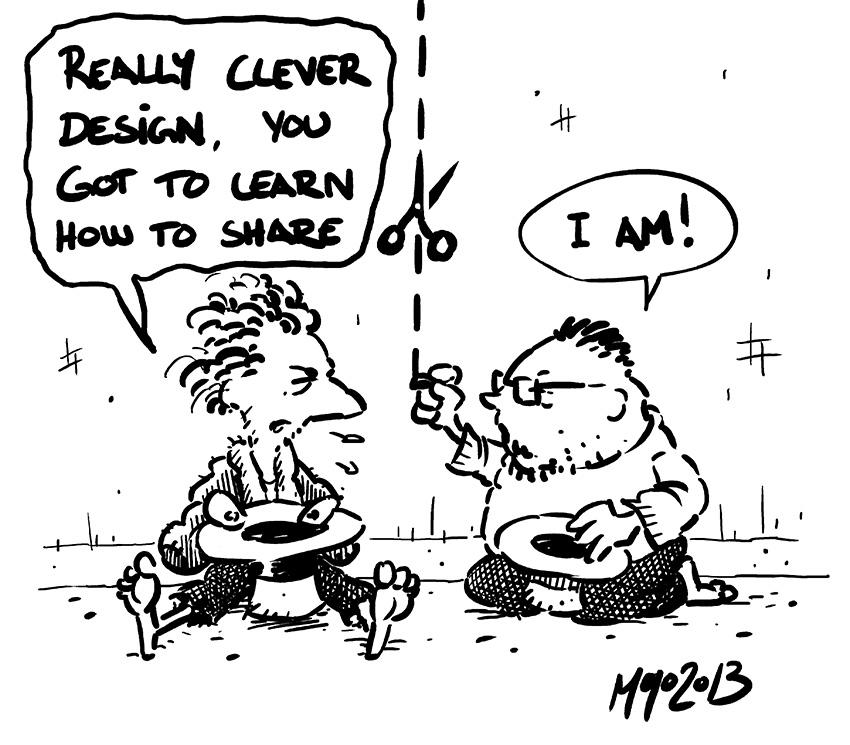Dear readers, I was given this opportunity, probably once in a lifetime, to write an essay on Design & Money. I was assigned to do it on a voluntary basis or in much more simple constructed words: “Do it for free”. I accepted those terms. To bring more transparency, I need to break down the concept of “Design & Money”.

Design has nothing to do with money — nothing at all! Design is a state of mind, a creative process of continuous development and improvement. Design is like art — a way to shape history; pointing out its beliefs and to be able to come up with great solutions that are practical and useful for that specific time-period. What’s important during the process is to accept the flow that makes it possible to bring great ideas to life. Ideally, design is about ideas that affect our present and how we create an idea for tomorrow, how we come up with meaningful solutions for the client, for the primary target, for the one who it might concern, for ourselves and for the purpose it’s intended to be used. Design is important from the perspective of profiling, understanding the market and applying a good quality aesthetic solution that the customer and market can accept for the reasons given in the context of a mission. Design is exactly what you think it is — You might be wrong but you should better try it first.
Money has nothing to do with design. It’s merely a tool of the trade; it reciprocates value for value. Money is not a concern except for those who wants to discuss the graphic and illustrated shape of money, but that’s another case. As a designer, you hold the most important tool in the process — the gift of accepting and converting a client’s need to a practical and useful design. Design has nothing to do with money but everything to do about creating a value.
In times of change we are forced to understand what value truly means and learn to be more flexible and be aware of the role of designers and money. This is increasingly true due to the fact that internet has emerged a powerful connecting tool in the recent years. From where I work I hear more and more often about businesses ordering their work from a wide range of countries were the pay rates are a bit lower compared to my country and companies are grabbing such opportunities of outsourcing their work, all in the effort to reduce costs.
Since a few decades it has become cheaper to print books in other countries and have them shipped backed again. Although we we have some great paper production companies and distributors over here it all boils down to the salaries of the workers, the stock and the rent. This will change further when the new digital reading tools are established and accepted on a broader market, and this in turn make printed material more or less confined to information-material or advertising & packaging design or exclusive printed books. How will this affect us as designers? What choices will we make for our clients? What’s the best medium of presentation for our clients’ needs? How can we take advantage of that knowledge?
We can, of course, give ourselves a greener world with digital distribution and online or offline digital design. When it comes to design and internet we will experience a wider market, when it comes to value and money we will experience a great change in competition since it will include designers from other countries taking part and offering services at their rates. More or less we are pushing ourselves towards a larger equality in the world economy and we need to keep in mind what the regular accepted costs are in other countries. But there are also other aspects than just world economy, an that is “The value of good design”. What are the customers buying? For what use and purpose is the intended design? Everything has a value and from a more interesting perspective it is the knowledge of how to create good design that fills and works for the consumers’ needs and in the best cases also gives other benefits. In those cases it will be more interesting as a designer to be not only talented but have a good reputation in the fields of quality and services as well as the costs. For some it will be better to accept royalty and licensing fee as additional perks. A third aspect is how and what regulates the copyright and how it changes depending on what country the designer or artist comes from. This will probably be a tricky part since not everything is bound by the Berne Convention and also it can be alarming for a customer who is not aware of how and where it can be used.
And then there is reputation, which is really hard to get. Even regular customers aren’t ready to spread your work by word-of-mouth unless they can find a value in endorsing your products. It only works out if you’re already popular and then customers use your name as another brand they own. Small firms have nothing to loose but larger corporations with more customers will either have to offer products and services at higher prices or have longer waiting lists depending on how many orders there are assigned to a designer.
Recently I got hooked up in a long conversation about customers who start their request with a “zero budget”. They would only pay the designer as much as a “bravo” or a handshake or tapping on the shoulders. It’s so easy fall for this simple trick. Either they will get a yes or no, or at least they will try to have a dialogue and get it for a bargain. They don’t want to pay what it usually costs. Working with such money-grubbing clients or working for a bargain or free doesn’t make a brilliant business model. In such cases its best to offer a royalty-based solution where your design fee depends upon the sales or plainly offer your services at your real prices with a no thank you note until they have come back to their senses; their needs won’t have gone away but they might just be forced to change their minds.
Clients know their budget and the possible earnings from their investment. As a designer it’s important to understand that as well since that’s the key to discuss proper payment. It’s also important to keep in mind all other factors that can affect the final design solution such as how the market will react, who the target audience is, how they will react to the design, the colors, the shapes and the messages being conveyed by the business. Another key to understanding value of your design is to research different economic and geographical regions, the standard practices and prices there. You should also include a legal disclaimer that prohibits the use of your design until the final payment is made.
Knowledge is the key to good service. Get the necessary knowledge and be service-oriented. But make sure that you don’t lose your time — which is now. It is in your hands to find and create value.

Magnus ‘Mojo’ Olsson
www.upphovsman.se
Swedish Illustrator, Artist and Graphic Designer

